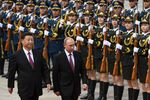Hal Brands

“For every thousand pages published on the causes of wars,” wrote the scholar Geoffrey Blainey half a century ago, “there is less than one page on the causes of peace.” A modified version of Blainey’s lament might usefully guide U.S. military planning today.
The Pentagon is getting serious about prevailing in the opening stages of a war with China or Russia. But wars between great powers rarely end after the opening salvo. The U.S. needs to be preparing for big, grinding conflicts that could drag on for months or years — and thinking as much about how those wars will end as how they might begin.
The scenarios for a war against China or Russia are easily imaginable. Beijing tries to invade Taiwan or make it surrender through bombardment and blockade. Chinese forces strike U.S. allies, such as Japan or the Philippines, in Asia’s inner seas. Russia launches a Baltic blitz against the North Atlantic Treaty Organization’s most exposed members.
American military planners have, appropriately, turned their attention to deterring these moves and fighting back if they occur. They are focusing especially on avoiding the fait accompli — where Russia or China uses military superiority around the target to quickly grab territory that is just too costly for the U.S. to liberate. So the Pentagon must amass the capabilities, and devise the concepts, necessary to break a Russian armored assault or sink a Chinese invasion fleet.
But then what? Even if the U.S. succeeded in blocking the first attack, the war might not end quickly. Ever since the Industrial Revolution and the advent of the mass army allowed countries to mobilize resources on a gargantuan scale, great-power wars have more often been long than short.
The Napoleonic Wars, the U.S. Civil War, World Wars I and II — all were decided by slow, relentless attrition rather than rapid, decisive annihilation. And even if Russia or China failed in the early stages of a conflict, they would have strong reasons to keep trying.
Russian strongman Vladimir Putin or Chinese leader Xi Jinping would surely fear that admitting defeat at the hands of the U.S. would leave their country geopolitically crippled. They would worry that starting, and then losing, a major war would imperil their political survival. In political science terms, they might “gamble for resurrection” rather than meekly concede.
China might mount second and third efforts to break Taiwan’s defenses, or try to strangle it economically. Russia could test NATO’s defenses in the Black Sea or on some other front. Either country could employ cyberattacks, long-range conventional strikes, or other capabilities to target the U.S. homeland and put pressure on its alliances.
The nightmare scenario involves Russia or China using, or threatening to use, nuclear weapons in hopes of making Washington back down in a struggle over small countries thousands of miles from America’s shores.
Stopping an opening assault on Taiwan or the Baltic states might prove to be the 21st century equivalent of France’s desperate stand on the Marne River in the opening weeks of World War I — a heroic, necessary defense that simply set the stage for a long, bloody conflict.
There are three main implications for the U.S. First, American war planning should focus not only on speed — how quickly the Pentagon can push powerful combat forces forward when the shooting starts — but also on endurance.
The outcome of a great-power war may be determined by what happens after the first campaign — who can ramp up production of missiles and other munitions, who can quickly replace lost ships and aircraft, who has the stronger, more adaptive industrial base and can better withstand the economic damage a conflict will inflict.
Properly arming for war is essential; rearming during a war will be vital, too.
Second, the U.S. will face the delicate task of both exploiting and limiting escalation. When wars go long, the combatants typically search for new sources of leverage: Witness Germany’s turn to unrestricted submarine warfare in World War I.
The U.S. could conceivably seek to end a protracted war with China through severe economic and technological sanctions, or through a maritime blockade that shuts off oil shipments and other key imports. But it may also need, through a mixture of firmness and restraint, to discourage an adversary from launching crippling cyberattacks or resorting to nuclear escalation. In America’s post-Cold War conflicts with weak enemies, the threat of escalation was mostly a one-way street. That won’t be the case in the future.
Third, the U.S. needs to treat the dilemmas of war termination as seriously as it does the challenges of warfighting. A violent showdown with a well-armed, nuclear-equipped foe is unlikely to end in a total U.S. victory or a complete enemy capitulation. The better America fares in a conflict with an authoritarian adversary, the more dangerous and unpredictable that adversary’s behavior may become.
The U.S. will need realistic thinking about what level of sustained coercion and destruction would be required to make a committed aggressor call it quits — and about what sorts of face-saving diplomacy might help bring an intense but limited fight to a close.
It doesn’t take much skill or foresight to start a big war. It may take a lot of endurance and creativity to end a great-power conflict somewhere short of disaster.
No comments:
Post a Comment